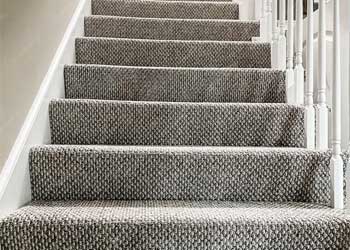It might be difficult to choose the ideal carpet for stairs because it needs to be the right thickness and durability. When it is trimmed, wrapped, and tucked around the edges of the steps and railing posts, it must also look nice. Carpeting your stairs is a smart option if you have small children at home or if you have steps that are frequently used. Continue reading to find out how to select the ideal carpet for your staircase.
Why Should Stairs Be Carpeted?
When compared to landing on bare, hard-surfaced stairs, soft, carpeted stairs can help reduce accidents from slips and falls. The noise produced by foot traffic will be absorbed and diminished by carpeted steps. Carpet can address aesthetic problems and add additional protection for the floor against wear and tear if your stairs have surface imperfections but are still solid in structure.
Select the Appropriate Material
Because of the increased force of gravity as you descend steps, footsteps have a higher impact on stairs than on level places.
A synthetic nylon low-pile carpet that is twisted or cut with a low pile height for stairs provides the best stability. A premium nylon Berber is an additional choice because of its texture, strength, and stain resistance. But make sure the particular carpet isn’t slippery, some polyester carpeting can be, which raises the possibility of slipping. If you own pets, be aware that some Berbers can catch tangled heaps.
Considering Thickness
When determining whether carpeting is appropriate for stairs, carpet thickness is a key consideration. Though too thick for the stairs, a thick, soft carpet with a high pile would be perfect for the bedroom. Overly thick carpets can be dangerous because they act as a downramp for your foot when they wrap around the nosing front edge of the stairs, leaving nothing substantial to support it from underneath. This can cause slips and falls.
Additionally, installing thick carpets on stairs is a task that carpet installers dislike. A thick carpet is harder to wrap around the nosing and between the railing pickets. The ideal carpet to choose will have a pile height of no more than 1/2 inch, a pile density rating of no more than 8 pounds, and carpet padding of no more than 7/16 inches.
Resistance of Soil
Staining and soiling are not the same thing. Even though spills are less likely to occur on the carpet in the family room than on the stairs, it is still wise to choose a carpet that is resistant to soiling for your staircase. This is due to the fact that when you walk up and down stairs, the oils on your feet and your pet’s paws can leave a residue on the carpet that sticks to the fibers and draws dirt particles.
Apparel and Aesthetics
However, stairs can be utilized by any type of carpet. When thinking about how a carpet would look when it “bends,” wraps around tread edges, or joins seams around posts, it can be helpful. Additionally, think about the carpet’s pile orientation and installation aesthetic. For reasons of aesthetics and functionality, the pile on stairs should always run vertically rather than horizontally. In addition, longer pile carpets, like friezes and some saxonies: may be better at hiding seams than shorter or looped piles.

Image From Freepik
